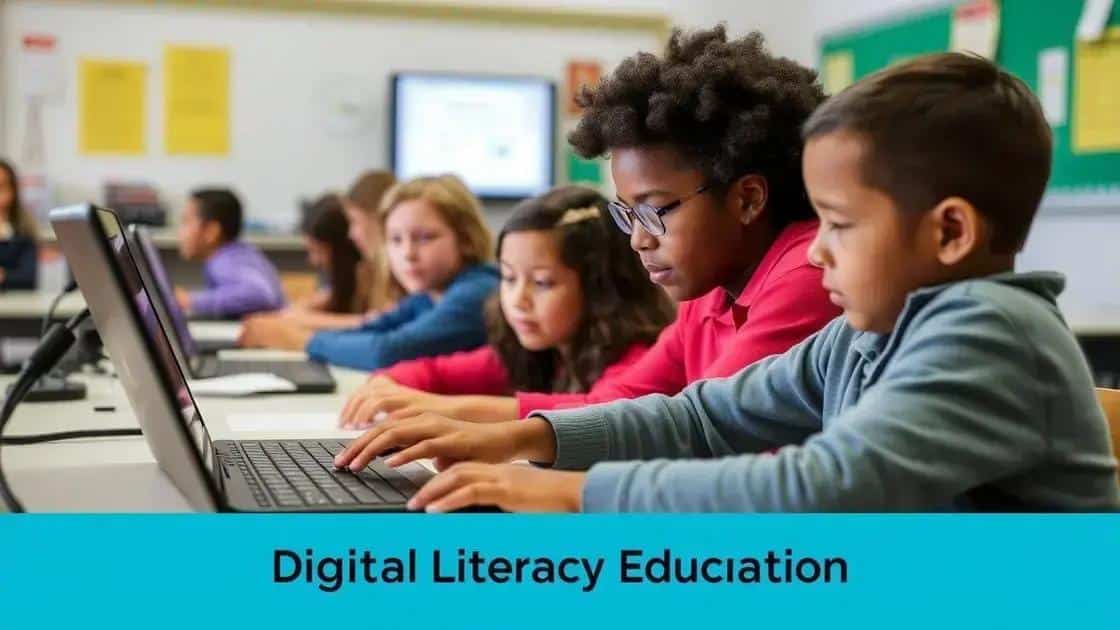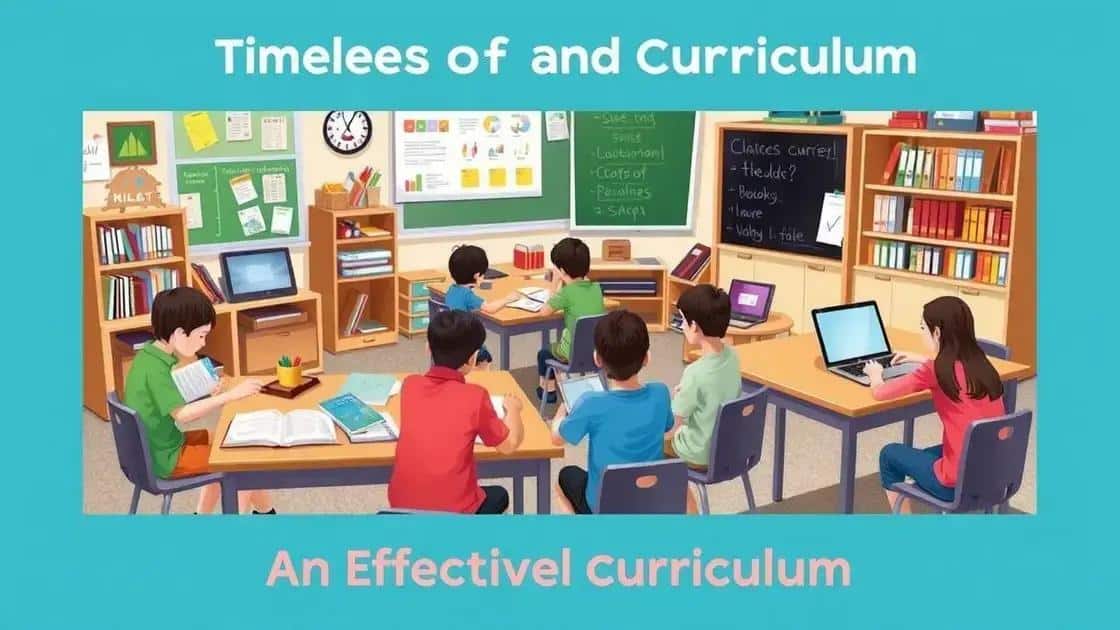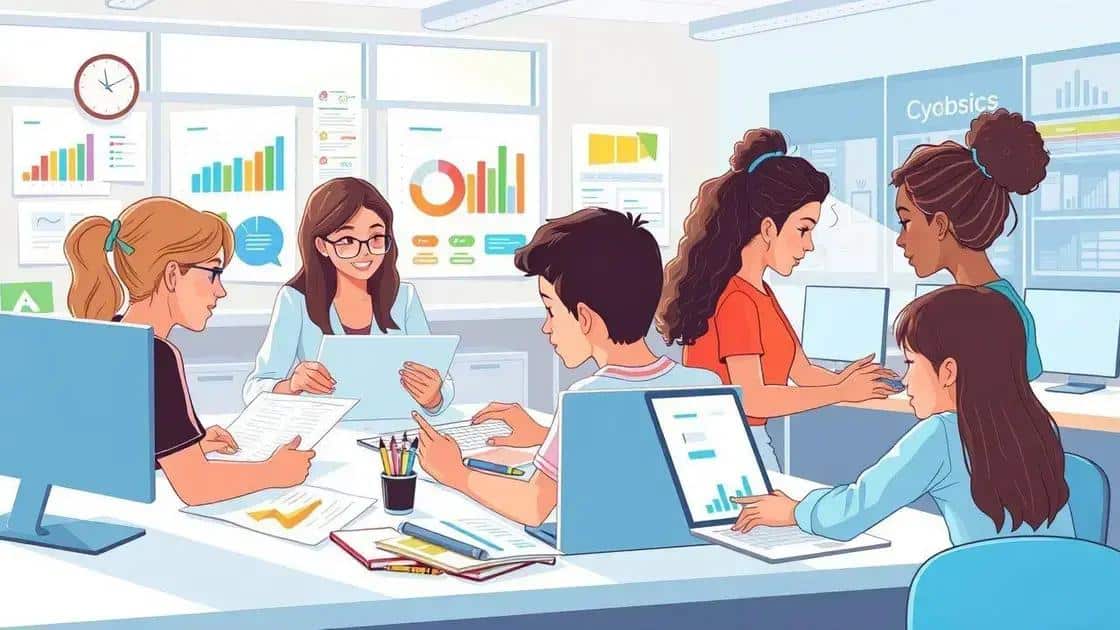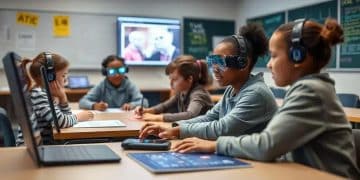Insights on digital literacy curriculum: a new perspective

Assessing the impact of digital literacy programs involves using standardized tests, qualitative feedback, observational data, and tracking long-term outcomes to understand their effectiveness in preparing students for a technology-driven world.
Insights on digital literacy curriculum are essential in today’s tech-driven world. Have you ever considered how these insights shape educational experiences for students? Let’s dive into this topic together.
Defining digital literacy today
Defining digital literacy today involves understanding a set of skills essential for thriving in a technology-driven society. In our modern world, being digitally literate is not just an option; it is a necessity.
To grasp the full scope of digital literacy, we should recognize its various components. These skills include the ability to navigate the internet safely, evaluate online information critically, and communicate effectively using digital tools. Students must also learn to collaborate and create content in a digital environment, making it vital for educators to integrate these competencies into curricula.
The Key Components of Digital Literacy
Some key aspects that encompass how we define digital literacy today are:
- Understanding how to use different devices and software
- Critically assessing the credibility of online sources
- Creating and sharing content responsibly
- Communicating clearly and effectively in digital formats
As technology continues to evolve, so does the definition of digital literacy. It is increasingly about preparing students for real-life applications. For instance, being able to utilize social media platforms safely and effectively is crucial for personal branding and professional networking.
Moreover, digital literacy also emphasizes the importance of ethical understanding. It encompasses respecting others’ rights online and knowing how to protect personal information. With more people connecting online, these elements become paramount.
Importance of Digital Literacy in Education
Integrating digital literacy into education is essential for several reasons:
- It prepares students for future careers
- It enhances critical thinking and problem-solving skills
- It fosters innovation and creativity
As we continue to redefine the educational landscape, digital literacy emerges as a foundational element that empowers learners to thrive both in school and beyond. To put it simply, understanding digital literacy equips students not just for academic success, but for active participation in society.
Key components of an effective curriculum

When discussing the key components of an effective curriculum, it’s essential to recognize that it goes beyond just content. An effective curriculum should engage students and enhance their learning experiences. By incorporating different elements, educators can create a well-rounded program.
One vital element is the alignment of learning goals with assessments. This ensures that what is taught matches how students are evaluated. Educators need to define clear objectives for each lesson. These objectives guide both teaching strategies and assessment methods.
Alignment of Learning Goals
Proper alignment helps to:
- Ensure all students understand expectations
- Promote consistency in teaching methods
- Facilitate meaningful assessments
Additionally, incorporating various teaching methods is crucial for an effective curriculum. Different students learn in different ways. This means that lessons should include a mix of lectures, hands-on activities, and collaborative projects. Such diversity keeps learning dynamic and caters to different learning styles.
Diverse Teaching Methods
To achieve this, educators can:
- Include group discussions to promote communication
- Utilize real-world problems for practical application
- Integrate technology to enhance engagement
Another essential component is the inclusion of feedback mechanisms. Regular feedback helps students understand their progress and areas for improvement. Similarly, it allows teachers to adjust their methods based on student performance.
Incorporating critical thinking and problem-solving within the curriculum is also vital. This empowers students to apply their knowledge to real-life situations, encouraging deeper understanding. When students engage in discussions or projects that require critical thinking, they often find the learning experience more fulfilling.
One must also consider the importance of resources and materials. An effective curriculum should incorporate a variety of resources, including books, technology, and community partnerships. These resources not only enrich learning but also provide different perspectives and insights, making education more comprehensive.
Strategies for integrating digital literacy in the classroom
Integrating digital literacy in the classroom requires thoughtful strategies that engage students and develop essential skills. It starts with teachers understanding the tools available and how to use them effectively in lessons.
One effective strategy is to incorporate technology into daily activities. Teachers can use interactive tools such as online quizzes and educational games to make learning fun and relevant. Engaging students with technology helps them become more comfortable using digital tools while reinforcing their learning.
Incorporating Technology Daily
Using technology in the classroom can:
- Encourage student participation
- Facilitate collaborative projects
- Enhance understanding through multimedia resources
Another important approach is teaching students how to evaluate online information critically. In an age where misinformation is rampant, students must learn to discern credible sources. This can be done through guided research projects, where students practice identifying reliable information while exploring topics of interest.
Critical Evaluation of Sources
To help students evaluate sources effectively, educators can:
- Provide criteria for assessing sources
- Conduct workshops on identifying fake news
- Encourage discussions about information reliability
Additionally, fostering collaboration among students can enhance digital literacy skills. Group projects enable students to work together, combining their strengths. This collaborative learning environment prepares students for future teamwork in digital spaces.
It’s also essential to create a safe online environment. Teaching students about online etiquette and the importance of privacy can significantly impact their online behavior. Discussing topics such as cyberbullying and digital footprints helps students understand their responsibilities in the digital world.
Lastly, providing continuous feedback is vital. Regular check-ins can help students stay on track and address challenges they might face. Feedback encourages growth and reinforces the importance of digital literacy in their educational journey.
Assessing the impact of digital literacy programs

Assessing the impact of digital literacy programs is crucial for understanding their effectiveness in education. These assessments allow educators to determine how well the programs meet their objectives and student needs. It’s not just about the tools used; it’s also about the skills students gain and how they apply them.
A key method for assessment is through standardized tests and quizzes that evaluate foundational skills in digital literacy. These assessments can highlight areas where students excel or struggle, providing valuable feedback to educators.
Standardized Testing
Using standardized assessments helps:
- Measure students’ grasp of key concepts
- Identify gaps in knowledge and skills
- Track progress over time
Another important aspect of impact assessment is qualitative feedback from students and teachers. Surveys and interviews can provide insights into how digital literacy skills are being integrated into everyday learning. This type of feedback offers a deeper understanding of student experiences and challenges.
Qualitative Feedback
Students and teachers might express:
- Thoughts on the usefulness of the skills learned
- Areas where they feel more confident
- Suggestions for improving the program
Additionally, observing students in a classroom setting can be beneficial. Teachers can assess how effectively students use their digital skills during group projects or individual assignments. This observational data can guide adjustments to teaching methods and curriculum as needed.
Using data analytics is also a powerful tool for assessing program impact. By collecting and analyzing data, educators can see trends and patterns that inform decisions. For example, tracking how students use technology can reveal whether they are engaging with content effectively.
Finally, assessing long-term outcomes is crucial for understanding the broader impact of digital literacy programs. Tracking students’ performance in subsequent courses or their readiness for jobs in a tech-centric world can provide insight into the true value of these programs. Over time, this reflects how well the skills gained are retained and applied beyond the classroom.
FAQ – Frequently Asked Questions about Digital Literacy Programs
What are digital literacy programs?
Digital literacy programs teach essential skills for using technology effectively, including internet navigation, online safety, and information evaluation.
How can I assess the impact of a digital literacy program?
You can assess impact through standardized tests, qualitative feedback from students and teachers, and observational data during class activities.
Why is digital literacy important for students?
Digital literacy is crucial because it prepares students for the digital world, helping them to be informed, responsible, and skilled users of technology.
What strategies can be used to integrate digital literacy in the classroom?
Strategies include incorporating technology into daily lessons, teaching critical information evaluation, fostering collaboration, and creating a safe online environment.





